AMD A10-7800 Review: Testing the A10 65W Kaveri
by Ian Cutress on July 31, 2014 8:00 AM ESTGaming and Synthetics on Processor Graphics
The faster processor graphics become, the more of the low end graphics market is consumed - if the integrated graphics are better than a $50 discrete GPU, there ends up being no reason to buy a discrete GPU. This might seem a little odd for AMD, who also have a discrete GPU business. The counter argument is that integrated graphics is only comparable to low-end GPUs, which are historically low margin parts and thus might encourage users to invest in larger GPUs, especially as demands in resolution and graphical eye-candy increase. The compute side is also important, and the homologation of discrete to integrated graphics architectures helps software optimised for one also be accelerated on the other.
F1 2013
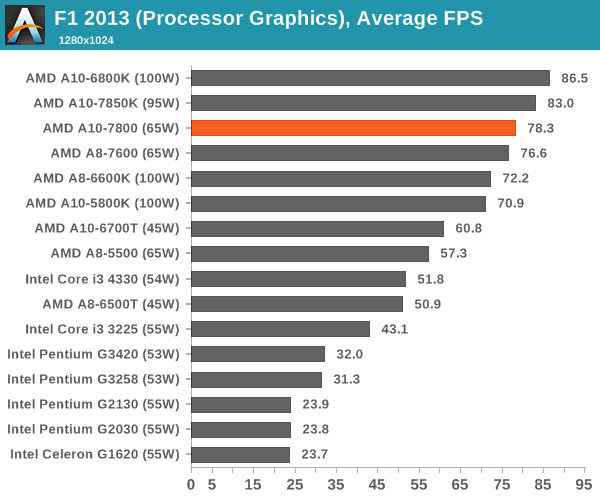
Bioshock Infinite
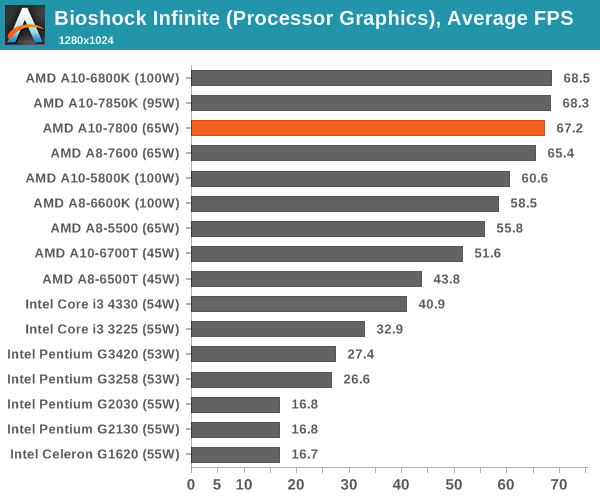
Tomb Raider
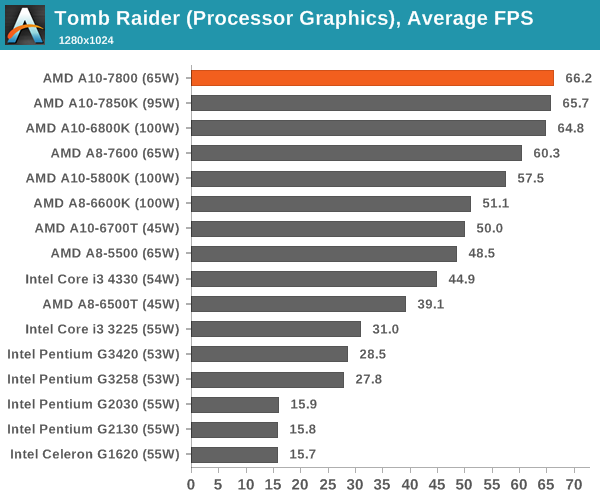
Sleeping Dogs
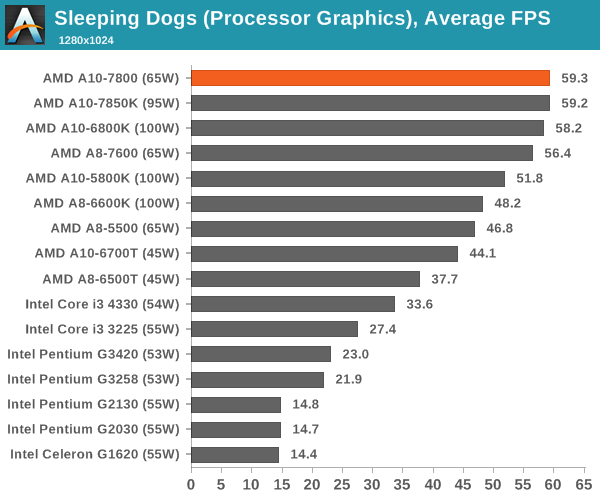
Company of Heroes 2

CompuBench 1.5
CompuBench is a new addition to our CPU benchmark suite, and as such we have only tested it on the following processors. The software uses OpenCL commands to process parallel information for a range of tests, and we use the flow management and particle simulation benchmarks here.
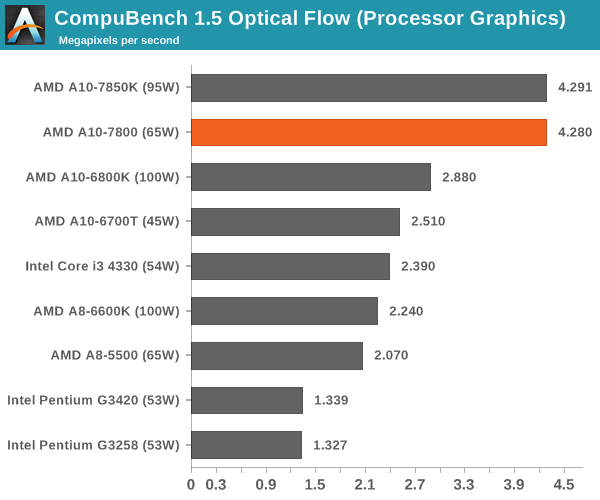
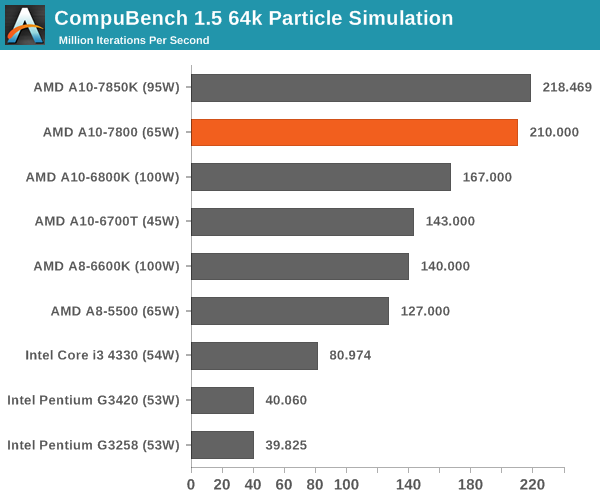
3DMark Fire Strike
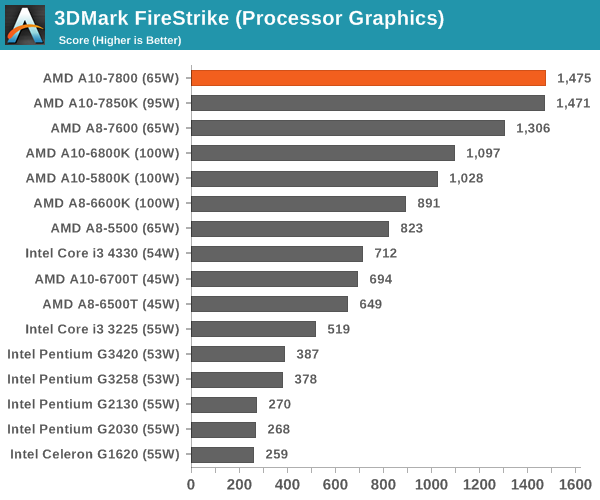
The simple answer is this: for anything related to processor graphics, AMD's Kaveri wins hands down and by a large margin in the same power envelope for cheaper.






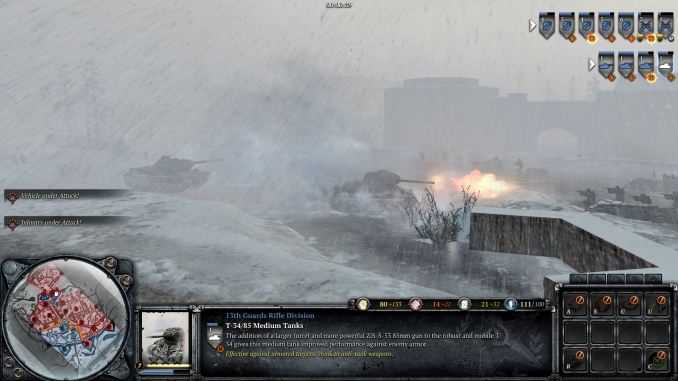








147 Comments
View All Comments
medi02 - Saturday, August 2, 2014 - link
About 40% of Steam users use INTEL'S iGPU.Another huge pack uses outdated GPUs.
Gamers = wasting money on idiotic rip offs like Titan is lame.
DJone - Friday, August 1, 2014 - link
1. 65W Kaveri A10-7800 costs $155, 65W Haswell i5-4590S costs $2002. The only proper mobo comparison is A88X vs. Z97 - both are high-end, and in general A88X mobos are cheaper.
3. For the price difference between A10 and i5 you can allways buy more expensive dGPU that will make A10 system faster than i5 system!
Haravikk - Monday, August 4, 2014 - link
I'm not sure I agree about the sentiment of wasting money on an integrated GPU if you get discrete graphics a year or two later. While it might be true today, the benchmarks including OpenCL performance show just how powerful a good APU can actually be, meaning it's an ideal physics accelerator even if you're using discrete graphics for pushing pixels. The issue really is whether games are going to take advantage of it, but I'm really hoping it will become a trend; it's certainly an area where AMD could really do with pushing some kind of physics on OpenCL library, as it's a prime candidate for an APU, even in a system with discrete graphics.But if you're looking for a properly budget system then an AMD APU is absolutely the best option IMO. Personally I wouldn't suggest the A10's for that though, but comparable A8's (are those out yet?) as they are far more cost effective, you could even get your system below $200 and still play a lot of games on good settings.
IUU - Wednesday, August 6, 2014 - link
" but would you seriously NEVER add a dGPU, even a year or two later?"No, I wouldn't. If I was so restricted that I couldn't buy a decent lowly dgpu... and would keep things simple , probably with lower power consumption too.
But this scenario is not valid even in developing countries, the exception being some really bad places where people actually starve. But these people, exactly because of their situation don't have any chance in computing.
So, AMD is in a really bad situation, but I don't believe for a moment that is actually a lack of talent responsible for this. What I am really afraid of , is maybe we have reached a kind of dead end(maybe temporary it doesn't matter). So, tech companies don't offer novelties, because they simply can't have any, or they are too few to waste hastily. Perhaps the new paradigm is not close and people in tech are panicking.. perhaps.
Drumsticks - Thursday, July 31, 2014 - link
The lowest priced i5 is $40 more than this, with only a 3 Ghz/3.2Ghz turbo. Then you consider needing to spend at least $100 to get good GPU performance, and +~$150 is not exactly in the same price bracket when we're talking about budget.Guspaz - Thursday, July 31, 2014 - link
The A10-7800 is slower than a dual-core i3-4330, and is only $38 cheaper than either the quad core 3.2GHz/3.6GHz i5-3470, or the quad core 3.2GHz i5-4460...For that extra 25% cost, the i5 will give you at least double the performance...
duploxxx - Thursday, July 31, 2014 - link
OMG. did you ever had a reality check? double performance? daily usecase there are 2 things slowing down a system:the choice of HDD vs SDD
the stupid windows OS.
All the rest is unreal theoretical benchmarking from review sites. the problem is as you and many more show every day, they actually believe theoretical benchmarking as true real performance.
poor it consumers....
Guspaz - Friday, August 1, 2014 - link
So go put an SSD in your Pentium Pro. Double the CPU performance for 25% more cost and less power consumption is a fantastic proposition for me.kmmatney - Thursday, July 31, 2014 - link
Double performance for what? I upgraded a while back from a Phenom II to a Core i5, and I have to admit the performance difference was minimal, as far as I could tell. going to an SSD is what really made things faster,and games are limited by my graphics card. For anyone using integrated for occasional gaming, AMD is a much better choice.You can make an argument that AMD is a good choice for a gaming rig, since you can save so much on the processor + MB that you can get a better graphics card. For example, if you buy the 3.9 Ghz quad-core A8 6600K + motherboard for $100, you have $200 left to buy a graphics card - given a $300 budget.
Guspaz - Friday, August 1, 2014 - link
This is true. AMD's processors generally offer good value, but terrible power efficiency... and they're often in the position where they've got the lowest absolute cost, but not the best performance-per-dollar.